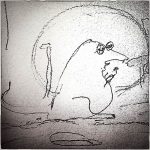Tag: journey
-
Alec Soth
Alec Soth website You Tube videos – many! Alec Soth (born 1969, Minneapolis, Minnesota, United States) is an American photographer, notable for “large-scale American projects” featuring the midwestern United States. His photography has a cinematic feel with elements of folklore that hint at a story behind the image. His work tends to focus on the “off-beat,…
-
Liz Nicol
In the Rubber Band Project (1997), Liz Nicol collaborated with her young son to make a body of work around the streets close to their home. Nicol’s son noticed and started collecting the rubber bands discarded by postmen on their deliveries. The pair began to set aside the bands collected on each day of the school run over…
-
Bernd and Hilla Becher
Typological method The Bechers’ grids pose questions about the nature of photography – as documentary collections of images of the world. They use a consistent technique (they used a 10” x 8” camera) applied to similar, or specific types of subjects – particularly functional industrial structures. The subtle individualities of these emerge through meticulous visual scrutiny of each, combined…
-
Nadav Kander
Kander’s website (flash based) Nadav Kander (born December 1, 1961) is a London-based photographer, artist and director, known for his portraiture and landscapes. Kander was born in Tel Aviv, Israel. His father flew Boeing 707s for El-Al but lost his eye and was unable to continue flying. His parents decided to start again in South Africa…
-
Chris Coekin
Chris Coekin website Chris Coekin’s monograph The Hitcher (2007) documents several years of hitchhiking throughout the UK. Coekin was drawn to hitchhiking as a unique form of transport, which relies upon the generosity of strangers and demands relinquishing some control over route or even destination. The Hitcher comprises self-portraits and incidental details that illuminate his journey (rubbish, mushrooms, prophylactics…),…
-
Paul Graham
Paul Graham website Paul Graham archive Great North Road Great North Road Vimeo Paul Graham (UK, 1956) belongs to that generation of photographers who were amongst the last to engage with the medium before it became part of the broader contemporary art world. At the beginning of the 1980’s Graham was among the first photographers…
-
Robert Frank
Robert Frank The Americans Robert Frank (born 1924), along with Diane Arbus and others, was one of the founder members of the New York School of photographers in the 1940s and 50s. The Americans, by Robert Frank, was a highly influential book in post-war American photography. With the aid of his major artistic influence, the photographer Walker Evans, Frank secured a Guggenheim…
-
Lee Friedlander
Lee Friedlander (born July 14, 1934) is an American photographer and artist. Friedlander studied photography at the Art Center College of Design located in Pasadena, California. In 1956, he moved to New York City where he photographed jazzmusicians for record covers. In 1960, the Guggenheim Memorial Foundation awarded Friedlander a grant to focus on his art and made subsequent grants in 1962 and 1977. 1960s and 70s: black…
-
John Thomson
edited from Wikipedia article Google images John Thomson (14 June 1837 – 29 September 1921) was a pioneering Scottish photographer, geographer and traveller. He was an accomplished photographer in many areas: landscapes, portraiture, street-photography, architectural photography. He was one of the first photographers to travel to the Far East, documenting the people, landscapes and artifacts of eastern cultures…
-
The Road
The road has featured prominently in art and literature as a means to get characters from one place to another, and as a stage for narratives to be played out. It has been used as a symbol for: notion of a journey – attaining greater understanding and with a coming of age, as explored in The…
